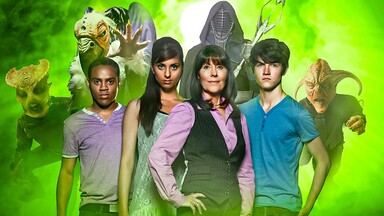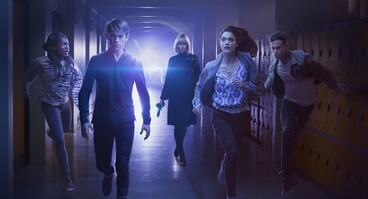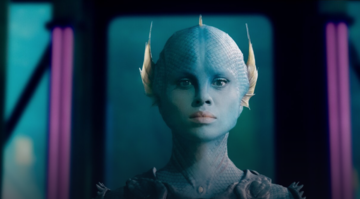There’s a strange kind of silence echoing across the WHOniverse. Not the loud crash of cancellation or the bombastic farewell of a finale; just stillness. Ncuti Gatwa’s Doctor has regenerated, the Fourteenth season closed with a flourish, and yet… no word. Fans wait for an announcement that has yet to materialise. Not angry; not outraged. Just quietly nervous. This isn’t the kind of silence we’re used to. It feels like the TARDIS has landed somewhere dark and isn’t making a sound.
And yet, the universe expands. While mainline Doctor Who hangs in limbo, BBC Studios and Bad Wolf push forward with a fresh momentum. Spin-offs, once speculative dreams whispered on forums, have taken form. The most prominent of these is The War Between the Land and the Sea, a six-episode mini-series centred on UNIT and featuring familiar names like Kate Stewart and Rose Noble. It has all the right pieces; seasoned characters, new threats, returning monsters. But without the Doctor anchoring it all, it faces the daunting task of proving it belongs.
This isn’t new territory. Doctor Who has spun itself off before, with varying degrees of success. Some of those efforts left their mark so deeply that fans still cite them in best-of lists; others fell into the vortex, remembered mostly as missed opportunities. But each tried, in its own way, to answer a hard question: what does the Doctor Who universe look like without the Doctor at the centre? And now, once again, that question returns.
So as UNIT prepares for war beneath the waves, let’s take a step back and look at the legacy this new show is walking into. Let’s revisit Torchwood, Class, The Sarah Jane Adventures, and the monsters who kept creeping back. Let’s ask whether The War Between the Land and the Sea is a clever evolution of canon or just a clever title. And maybe — just maybe — find hope in the stories that shaped the spin-offs that came before.
Torchwood: When Doctor Who grew up
If Doctor Who is the madman in a box, then Torchwood was the one who cleaned up after he left. Launched in 2006, this gritty spin-off didn’t so much expand the WHOniverse as it did peel back its layers. It was unapologetically adult. Sex, trauma, alien gore, moral compromise — nothing was off-limits. And yet, it wasn’t gratuitous. Torchwood was always trying to say something, even when it was breaking your heart.
At its core stood Captain Jack Harkness, a character who had already danced his way through time and space. But in Torchwood, Jack wasn’t the charming rogue anymore. He was burdened. Haunted. A leader trying desperately to be human again. His team — Gwen, Ianto, Tosh, Owen — weren’t archetypes. They were damaged, real, and entirely unprepared for what the universe kept throwing at them.
What made Torchwood work wasn’t just its darker tone. It was its connection to the mythos without depending on it. You didn’t need the Doctor to walk through the door to know this was the same universe. The writing never forgot where it came from. Take the Face of Boe reveal — Jack’s eventual fate wasn’t just a twist; it redefined episodes from both shows. Suddenly, the timeline felt like a web. One tug, and everything else shifted.
And while its final season, Miracle Day, may have been divisive, Children of Earth remains one of the most powerful stories ever told under the Doctor Who banner. It was bleak, bold, and unforgettable. Torchwood proved you could tell mature, character-driven stories in this universe. It built lore. It expanded canon. It earned its place.
Class: The spin-off that couldn’t
In contrast, Class arrived with the weight of expectation and collapsed under it. Created by A Monster Calls author Patrick Ness, the show was pitched as a YA entry point for newer viewers — think Buffy the Vampire Slayer meets Coal Hill Academy. On paper, it made sense. Coal Hill has always had ties to the Doctor; why not explore the lives of those left behind?
But Class never quite found its footing. It had moments — flashes of character depth, surprisingly violent twists, and a dark sensibility that hinted at bigger things. And yet, it felt like it didn’t know what it wanted to be. Was it horror? High school drama? Sci-fi soap? The result was a tonal mismatch that alienated core fans and confused newcomers.
Worse still, it lacked the connective tissue that made Torchwood feel essential. A single brief cameo from Peter Capaldi’s Doctor in episode one wasn’t enough to root the series. Without ongoing ties to the broader universe, Class felt like a side quest with no stakes. It introduced new monsters and lore but didn’t earn our investment in them.
It also couldn’t escape the shadow of The Sarah Jane Adventures, which had already done “school-based Doctor Who” far better. While Class chased edginess, SJA balanced light and dark with grace. It respected its young audience instead of trying to impress them. And that difference in tone made all the difference in reception.
The Sarah Jane Adventures: Legacy and light
If Torchwood was the dark mirror, The Sarah Jane Adventures was the heart. Running from 2007 to 2011, it followed the beloved companion Sarah Jane Smith — portrayed once again by Elisabeth Sladen — as she protected Earth from alien threats while mentoring a group of young allies. It was charming, emotionally sincere, and brimming with love for the universe it belonged to.
Unlike Class, SJA never tried to distance itself from the source. The Doctor appeared frequently — not as a crutch, but as a friend dropping by. Both David Tennant and Matt Smith made cameos that felt earned. The show even tackled major lore moments; the Trickster, the Judoon, Slitheen, and even a lost Gallifreyan AI all found their way in.
More than that, the show was thematically rich. It handled loss, identity, fear, and growing up with surprising maturity for a children’s show. It taught its audience that being kind and brave mattered. It gave us found families, heartwarming reunions, and a Sarah Jane who never stopped fighting, even after leaving the Doctor behind.
Its most poignant contribution may have been behind the scenes. When Elisabeth Sladen passed away, the show ended not with a bang, but with a tribute. Her impact was so profound that even the Doctor mourned her on screen. No other spin-off has carried that kind of emotional weight.
And let’s not forget the deep world-building. The show quietly linked itself to broader Who lore. The Bannerman Road gang had more interactions with the universe than some modern companions. In its own gentle way, The Sarah Jane Adventures helped keep the WHOniverse feeling whole.
The return of the Sea Devils
And now, in The War Between the Land and the Sea, the Sea Devils return — and so does UNIT. First introduced in the 1970s during the Third Doctor’s era, the Sea Devils were underwater reptilian humanoids who challenged humanity’s dominance over the Earth. They were ancient; not evil, but displaced. Their war with humans was tragic, not monstrous.
In many ways, their return now feels poetic. Kate Stewart — daughter of Brigadier Lethbridge-Stewart, who famously fought the Sea Devils alongside the Doctor — now faces them in her own right. There’s a circular beauty in that. The children of the old guard now holding the line.
This could be more than just a monster-of-the-week scenario. If handled right, it’s an opportunity to reflect on legacy — both UNIT’s and the show’s. Can you fight the same war your parent did and still come away with your soul intact? Are we destined to repeat these battles, or can we finally broker peace?
The Sea Devils are intelligent. They speak. They reason. Which means this war could play out on more than one front — political, emotional, even personal. Rose Noble’s presence opens up an opportunity to see how someone newer to this life processes such a high-stakes conflict, and how someone like Kate, born into it, balances duty and morality.
And while we don’t know how heavily this conflict will lean into the philosophical, there’s a real chance to make the Sea Devils more than just nostalgic villains. If Davies leans into their tragedy, this could be one of the more nuanced portrayals of legacy monsters in recent memory.
New UNIT; new story
The team assembled for The War Between the Land and the Sea feels fresh but grounded. Alongside Kate and Rose, we have newcomer characters like Morris Gibbons (Bhav Joshi) and Colonel Ibrahim (Tachia Newall). We also have Andrea Salt (Susan Twist), whose appearances throughout the mainline show have made her something of a mystery — and now she’s the antagonist.
The inclusion of Rose Noble is particularly intriguing. As the daughter of Donna and companion-by-proxy, she carries emotional baggage and raw potential. We’ve seen hints of what she’s capable of; this series could push her further into the spotlight. Will she become a UNIT regular? Or does this conflict set her on a different path?
What makes this team exciting is its balance. Kate represents order; Rose brings heart; Morris and Ibrahim are unknowns — and that’s where the tension lies. This isn’t just about fighting monsters. It’s about how different people handle crisis. Some follow the rules. Others improvise. Some fall apart. UNIT has always been about more than guns and protocols; it’s about holding the line when everything else breaks.
This show could also open the door to other spin-offs. A successful UNIT series might lead to character-based sequels or specials, the way Torchwood spun stories out of individual team members. It could become the base from which future stories jump — not a side quest, but a staging ground.
And then there’s Salt. Her role as antagonist is still shrouded in mystery, but the fact that she’s shown up across multiple timelines suggests something larger is at play. Time isn’t just a backdrop in Doctor Who; it’s a weapon. And Salt may be the one holding it.
Final thoughts: Will it hold?
There’s no guarantee that The War Between the Land and the Sea will succeed. Being a mini-series, it’s likely self-contained. If it doesn’t land, it may vanish quietly. But if it does — if it resonates, if it builds, if it connects — it could become the model for future expansion.
Russell T Davies has proven he knows how to build a universe. He did it once before with Torchwood and The Sarah Jane Adventures. Those shows didn’t just add side quests; they built lore. They connected past and future. They gave the Doctor’s absence meaning.
So this isn’t just a question of whether UNIT can fight monsters. It’s a question of whether this show can carry legacy without leaning on the Doctor’s shadow. Whether it can stitch together a fandom still reeling from uncertainty. Whether it can stand on its own — or if it’s just another fixed point the writers forgot.
The War Between the Land and the Sea will release some time in late 2025.
Source(s)
Own opinion and experience
Image sources: BBC, John Barrowman - official website, Rotten Tomatoes


















